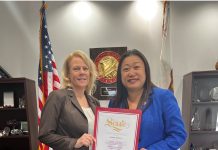Just six weeks after its formation, the newly established View Equity Committee seems determined to deliver on putting teeth in a new city ordinance.
But first they want a test drive, to understand how a potential view equity claim would play out under the model adopted by Rancho Palos Verdes, which passed one of the state’s first view-protection ordinances in 1989.
At their third meeting on Tuesday, four committee members reported their findings from a field trip last week to pick the brains of Palos Verdes city officials.
The committee agreed to use 10 real view equity disputes from residents who attended the meeting as working case studies, to assess how a hypothetical ordinance would work and uncover potential road blocks in establishing what constitutes a property owner’s rightful view, and guidelines for actionable rules to restore, protect or maintain that view.
The city’s current view ordinance was adopted in 2003, but lacks enforcement remedies. In January, Mayor Kelly Boyd’s council colleagues endorsed his push to strengthen the law’s provisions by year’s end.
Committee members, Planning Commission member Ken Sadler, Design Review Board member Roger McErlane, landscape architect Bob Borthwick, attorney Larry Nokes, architect Morris Skendarian, emergency disaster preparedness committee member Sue Kempf, landscape architect Susan Whitin and Chris Toy set to work.
The subcommittee of Kempf, Whitin, McErlane and Toy, who joined city development director John Montgomery and principal planner Carolyn Martin on the excursion to Palos Verdes, shared their observations with the other committee members and an audience of about 30 residents.
There, a claimant must first contact the neighbor with the offending vegetation directly to try to find a solution. The next step is a city-paid mediator skilled in conflict resolution, rather than a landscaping expert or city employee.
If mediation fails to resolve the problem, then the property owner can file a city claim, with a $5,100 filing fee. City planners visit the site with the obstructed view before holding a public hearing, after which they make a binding decision. If the vegetation is to be trimmed or removed, the vegetation owner has 90 days to comply, and the claimant pays for the tree trimming, though future pruning falls to the vegetation owner. However, if the owner of the offending vegetation refuses to comply, the claimant can contact code enforcement officials, who they will give the vegetation owner 30 days notice before the city hires pruners and puts a lien on the property for the cost.
Initially, Palos Verdes officials received about 20 claims a year, but now 90 percent of view disputes are resolved in mediation, committee members reported. If the city’s annual $42,000 mediation budget is exhausted, claims must wait until the next year.
Palos Verdes’ ordinance has withstood a 2001 court challenge, Kempf said.
Ways to tweak RPV’s ordinance to suit Laguna’s needs ensued, including how to define the views to be protected and how many views a homeowner might claim. Kempf noted that Palos Verdes makes a distinction between “near” and “far” views, and that they also allow only one defensible view per home, so that the homeowner must choose the “most significant and best view.”
Nokes supported the need for a high claim fee to protect against frivolous claims, and “a hammer at the end to make it worth paying the fee, if it really comes to that.”
Committee members made it clear they do not want to eradicate trees, but promote responsible maintenance of vegetation.
While Palos Verdes generally establishes baseline views with aerial photos of the lot when first developed, committee members recognized that likely won’t work for Laguna, where many homes were built in the 1920s and ‘30s when trees were scarce.
Residents in attendance were invited to submit their view problems to Kempf. The committee will then parcel them out between two smaller groups, visit the sites and conduct case studies that they will report on at their April 23 meeting.
One question that arose was the role of the Design Review Board in assessing new vegetation before it is planted. Currently, the board has authority to review landscape plans submitted along with remodeling projects, but most home landscaping projects are not subject to board review at all.
Nokes said certain plantings perhaps should require DRB scrutiny. Sadler suggested the issue might be addressed at the joint City Council, Planning Commission and Design Review Board meeting to be held this Saturday, March 16, at 9 a.m. at the Susi Q Center.
The next meeting of the View Equity Committee will be held at 4:30 p.m. on Tuesday, April 9, at the Susi Q Center.




